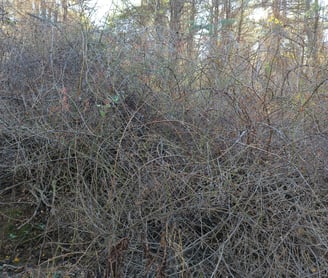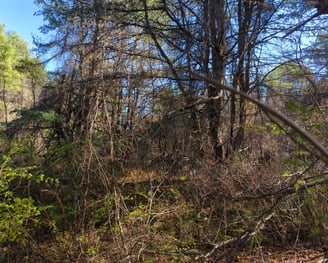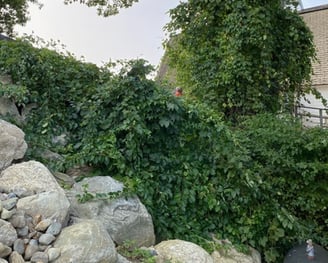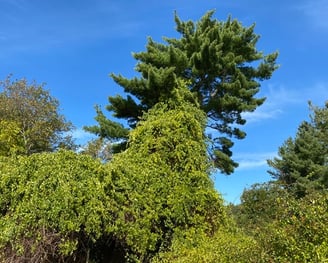Invasive Plant Rogues' Gallery
A few of the most common invasive plants in Lincoln County merit a special distinction of dishonor. Particularly harmful to woodlands, they are extremely tenacious, and seem to be popping up everywhere!
For a more complete list of invasive plants in Maine, visit our friends at the Maine Natural Areas Program.


Bittersweet (Celastrus orbiculatus)


Bittersweet vines are an ugly mess!
A perennial woody vine, bittersweet climbs mature trees by twining around trunks and branches, effectively strangling the tree. When spread widely through trees' upper branches, the tree is cut off from sunlight, and will often break under the increased weight.
This is a tough plant to remove once it is even slightly established. While the vines can (and should) be cut, it aggressively re-sprouts from any section of its wide root network.
Knotweed (Fallopia japonica)


Knotweed - absolutely demonic resilience!
This perennial grass has stalks similar to bamboo which can grow up to 10' tall. Brought from a volcanic island as an ornamental, this is a tough plant that has become widespread throughout Lincoln County. It spreads extremely easily, as any stem node or root fragment can produce a complete plant in a new location. This is particularly problematic along river banks where spring flooding carries root fragments downstream, and along roadsides when winter sand yards are infected.
This is an extremely hard plant to remove. Repeated cutting over many years may eventually suppress annual re-growth, although some studies have suggested that cutting increases rhizome root activity, causing the cut plant to actually re-grow and spread faster. If you do opt to cut, take extra care that all severed pieces are bagged and disposed of properly.
Black Swallowwort (Cynanchum louiseae)


The green leaves may look pretty, but this is problem vine spreads quickly and is deadly to monarch butterfly larvae.
A perennial thin woody vine, swallowwort is rapidly spreading through out Lincoln County. Related to milkweed, this plant also spreads seeds on airborne white tufts.
Possibly the worst news about this weed is that it can confuse monarch butterflies so they lay their eggs on black swallowwort instead of milkweed. Unfortunately, the swallowwort is 100% fatal to the hatched larvae.
Multiflora Rose (Rosa multiflora)


XXX
A perennial deciduous shrub, multiflora rose can grow up top 20' tall, sending long stems into the upper story of trees. With vicious thorns, the plant will continue to re-sprout unless the root bole is completely dug out or treated with herbicide.
Barberry (Berberis thunbergii)


Left unchecked, barberry out-competes native plants creating dense infestations.
A perennial deciduous shrub, barberry is often planted as an ornamental. With short, sharp thorns it produces distinctive oblong red berries in later summer. These berries are favored by wild turkey and grouse, who eat the fruit and spread the seeds far and wide.
Some studies have also identified a link between barberry and ticks, leading to the nickname "tick motel" for this invasive plant.
Shrubby Honeysuckles (Lonicera morrowii and Lonicera tatarica)


A mature stand of invasive honeysuckle.
Another perennial deciduous shrub, invasive honeysuckles out-compete native shrubs by leafing out early and dropping late. This blocks sunlight from other plants, allowing the bush to spread further.
